Experts from federal universities discuss carbon neutrality in Russia
St Petersburg University, with the support of the Association of Leading Universities and the Council of Rectors of the Northwestern Federal District, has organised a round table ‘Carbon Neutrality in Russia: Challenges and Opportunities’. The event was held online.
The event brought together participants from 21 subjects of the Russian Federation from Kaliningrad to the Far East. Representatives of 15 research and educational organisations from nine constituent entities of the Russian Federation delivered their reports.
The meeting discussed a range of issues. Among them were: assessing emissions and sinks of greenhouse gases; preparing climate safety passports for the constituent entities of the Russian Federation; and developing proposals to create carbon polygons. The meeting also discussed emerging technologies that would define capturing, transporting, storing and processing carbon. Additionally, it focused on the financial, economic and legal aspects of the sequestration industry in the Russian Federation.
The round table was moderated by Kirill Chistiakov, Director of the Institute of Earth Sciences at St Petersburg University, Vice President of the Russian Geographical Society.
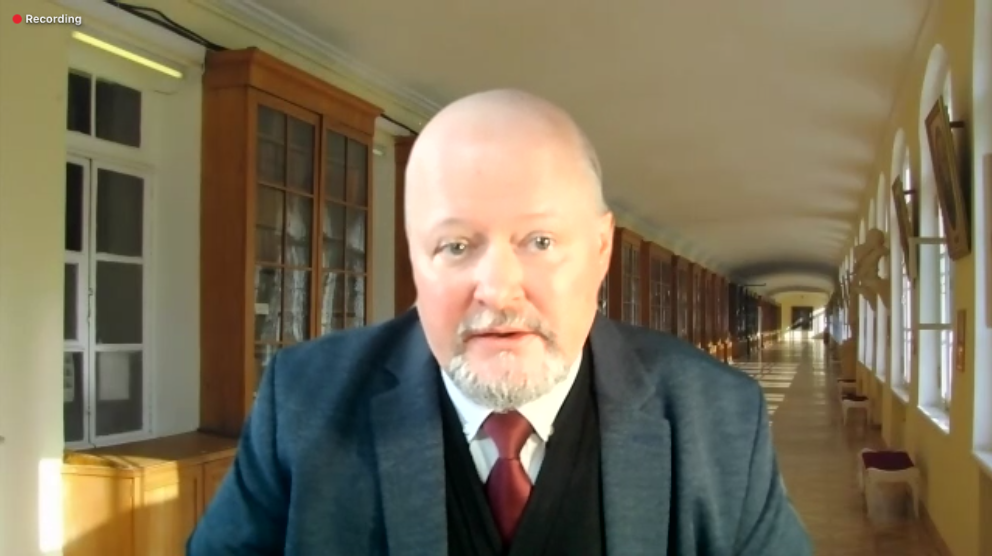
‘The issue of carbon neutrality is extensively covered by the media and is rigorously discussed in research. Carbon neutrality is associated with the issue of climate change, which dates back to the 18th–19th centuries. It was the time that brought the scientific and technological revolution that has eventually determined our civilisation. It also generated a range of opinions about the disappearing fertility and the need to regulate the relationship between humans and nature. As early as the 19th century, leading researchers studied the climate mechanisms. When it comes to the effect the carbon dioxide may produce on the temperature in the atmosphere and the Earth’s surface, we should recall Svante Arrhenius. He was a Swedish physical chemist, author of the theory of electrolytic dissociation, and won Nobel Prize in Chemistry. In 1896, he accurately assessed the effect of carbon dioxide gas on temperature. Yet he did not take into account various aspects of climate formation. These aspects were discussed later. In the works of many scientists, we can find different aspects of the analysis of what is happening on Earth. All these works of both Western and Russian authors slowly but surely have developed the idea that human activity influences the conditions on our planet. Evidently, energy and greenhouse gas emissions are not comparable to the natural processes such as volcanic eruptions. Yet our activities influence the land, spread into the oceans, and can be a trigger for global environmental changes. In this regard, our activity affects our future and subsequently raises questions of self-regulation and self-discipline,’ said Kirill Chistiakov.
The work of the round table was continued by the report ‘Approaches and methods for studying the organic matter of soils of carbon polygons in Russia’ delivered by Evgeny Abakumov, Head of the Department of Applied Ecology, Professor at St Petersburg University.
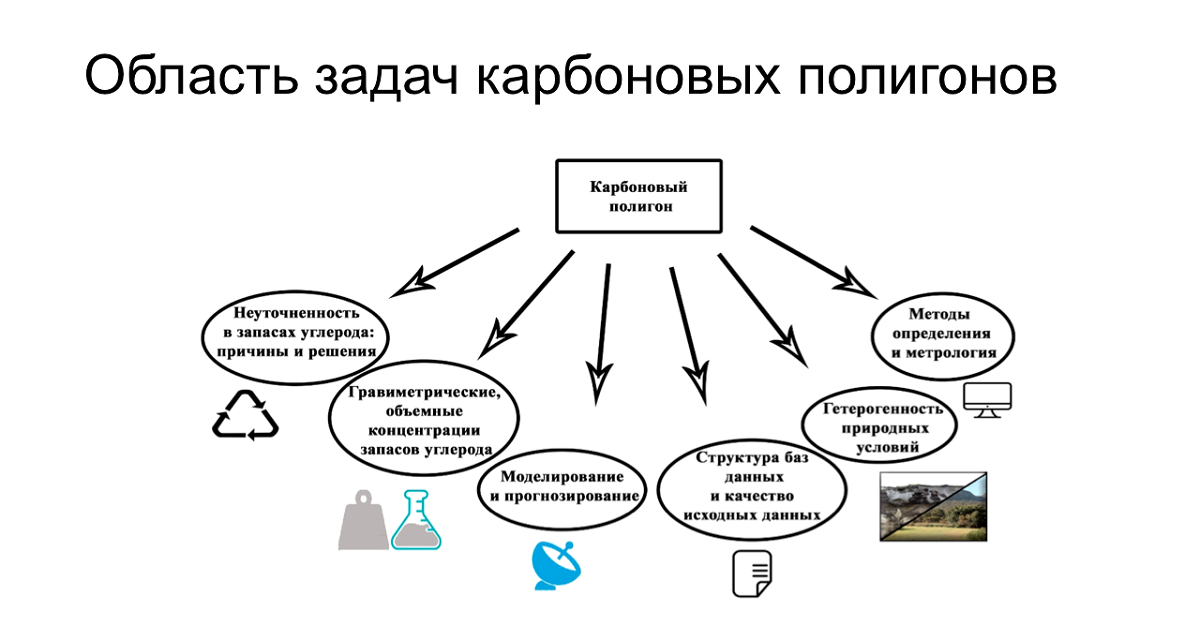
At carbon polygons, we can conduct serious studies in the field of ecology, such as the development and adaptation of ground-based technologies for field and forest agrochemical control of soils and greenhouse gas respiration. Additionally, we can study technologies for remote accounting of aboveground and underground phytomass, rhizosphere, agrochemical control of soils and greenhouse gas respiration to name but a few.
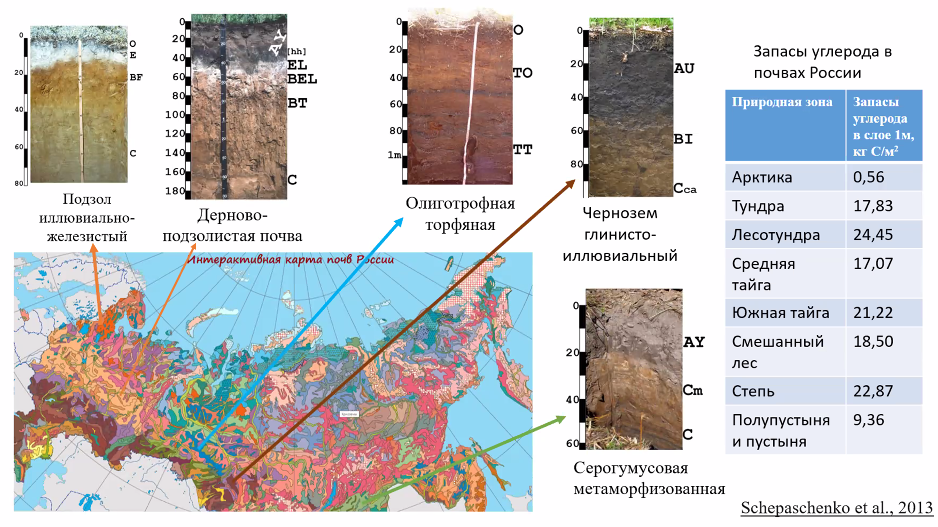
‘The soil is not the largest, but the most significant part of the carbon polygons. The soil cover in Russia is extremely diverse. Carbon stocks in soils of various types range from a few hundred grams per square metre (if we take a cubic metre of soil section) to tens of kilograms (sometimes even more than a hundred kilograms). Each carbon polygon has a heterogeneous structure of the soil cover, even within one hectare. We face not only methodological, but also metrological questions. Among them are how to measure, what to measure, and where to measure. Soil carbon is at least five types of soil organic carbon that we are losing intensively. When the founder of domestic soil science Vasily Dokuchaev and Dmitri Mendeleev measured carbon in black soil, this figure was at a level of more than 10%. Today, it is 6–7% at most. In other words, we have lost a huge amount of carbon due to erosion and emissions,’ said Evgeny Abakumov.
Carbon polygons are territories with a unique ecosystem created to implement the measures to control climate active gases with the participation of universities and research organisations.
Emission of carbon dioxide is a process that characterises the release of CO2 from the soil surface into the atmosphere. According to Professor Abakumov, Head of the Department of Applied Ecology, it is mostly about anthropogenic-induced emission, which is intensified due to the mineral fertilisers in the soil.
‘This is an unnecessary emission. The estimates are very different. Yet the error in these estimates, unfortunately, in our country is approximately 25%. Among the tasks the carbon polygons are set to deal with is to reduce this error to at least 10%. Then we will be able to more confidently defend our carbon interests and competencies in the international market,’ emphasised Evgeny Abakumov.
A pilot project to create carbon polygons in the regions of Russia for the development and testing of carbon balance control technologies was launched by the Ministry of Science and Higher Education of the Russian Federation in 2021. The implementation of the project to create carbon polygons is in line with: the National Action Plan for the First Phase of Adaptation to Climate Change for the Period up to 2022 approved by the Government of the Russian Federation in December 2019; and the Strategy for Scientific and Technological Development of the Russian Federation adopted in December 2016.
Maria Makarova, Senior Researcher at the Department of Physics of Atmosphere, presented the results of experimental studies that focused on emissions of climatically and environmentally important gases into the atmosphere in the territory of the St Petersburg agglomeration.
‘My report focuses on one of the challenges on the way to carbon neutrality. It lies in the fact that reporting on greenhouse gas emissions and scientific climate data are not always consistent. The accuracy of regional climate modelling depends on a number of factors. One of these factors is adequate and comprehensive information about the anthropogenic impact. The anthropogenic impact reaches its maximum values in industrial regions and areas with high population density, i.e. modern megacities. Megacities are not only “heat islands”, i.e. a meteorological phenomenon that is the disturbance of the natural climatic regime of the territory by urban conditions. These “heat islands” are also significant sources of emissions of various substances into the atmosphere, including greenhouse and reactive gases. In 2019, 2020, and 2021, a mobile experiment EMME (Emission Monitoring Mobile Experiment) was conducted on the territory of the St Petersburg agglomeration (Russia) to assess emissions of greenhouse gases (CO2 , CH4 ) and chemically active gases (CO, NOx) in St Petersburg, which is the largest northern metropolis,’ said Maria Makarova.
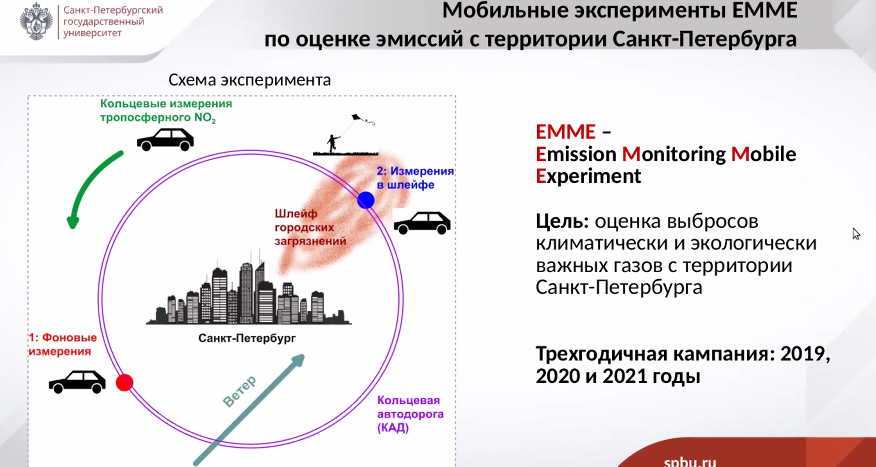
The mobile experiment EMME was carried out jointly by St Petersburg University, the Karlsruhe Institute of Technology (Germany), and the University of Bremen (Germany). The purpose of the experiment was to estimate emissions of climatically and environmentally important gases in St Petersburg. The experiment concluded that we needed to conduct additional studies to prove the reliability of data on greenhouse gas emissions in the territory of the St Petersburg agglomeration.
Artem Pavlovskii, Acting Head of the Department of Climatology and Environmental Monitoring, raised the issue of developing a climate safety passport and a regional climate change adaptation plan.
According to the National Action Plan for the First Phase of Adaptation to Climate Change for the Period up to 2022, the subjects of the Russian Federation should submit proposals to correct strategic planning documents. The expected result is to incorporate the measures for adaptation to climate change. Additionally, the subjects of the Russian Federation should prepare regional plans for adaptation to climate change. The expected result is to develop a system of operational and long-term measures for adaptation to climate change at the regional level.
‘St Petersburg University experts have been actively engaged in the preparation of these documents over the past few years. For example, we justified introducing flood zones in St Petersburg. It was part of the study to determine the maximum area of alluvium in the water area of the Neva Bay in order to maintain its storage capacity in floods. We started developing a climate safety passport and an adaptation plan to climate change for St Petersburg. Additionally, we are members of the working group on the development of regional climate change adaptation plans in St Petersburg and the Leningrad Region,’ said Artem Pavlovskii.

According to Artem Pavlovskii, St Petersburg has both global climate trends and local features associated with the ‘heat island’. In this regard, large cities that are the subjects of the Russian Federation (St Petersburg, Moscow, Sevastopol) have a number of specific features that must be taken into account when preparing climate passports and adaptation plans. One of the most adverse effects of climate change on our city is rising sea levels.
‘Today, St Petersburg meets the parameters of the climatic zone which differ from those specified in the regulatory documents. By 2050, the construction and climatic region at the location of our agglomeration may fundamentally change, which must be taken into account in the general plan of the city and in the scheme for the joint development of St Petersburg and the Leningrad Region,’ said Artem Pavlovskii.
Climatic construction area is a construction zone, the boundaries of which are determined by climatic characteristics that affect the thermal balance of buildings and the bioclimatic comfort of development areas.
The last speaker from St Petersburg University was Nadezhda Lvova, Doctor of Economics, Professor in the Department of Credit Theory and Financial Management. She spoke about the theory and international practices of sustainable finance. She focused on the concept of sustainable finance, the range of practical solutions in the field of sustainable finance, and the mobilisation of financial resources for sustainable carbon neutral development.
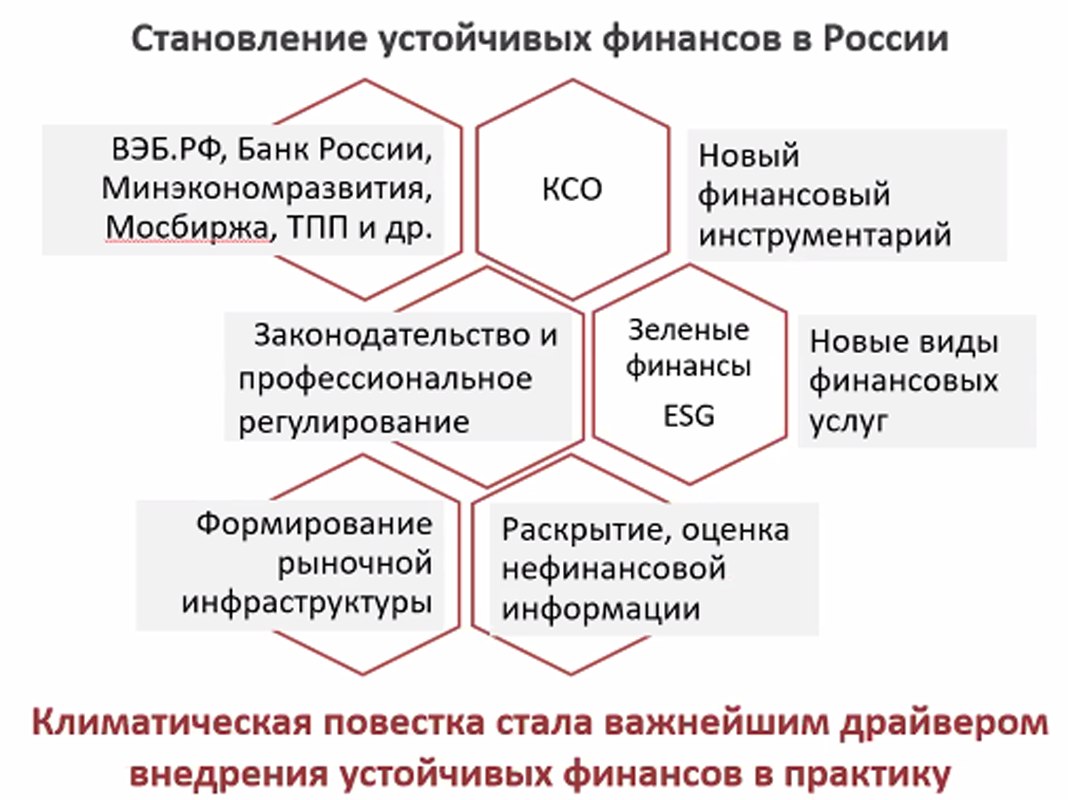
There are three levels of scientific understanding of sustainable finance, said Nadezhda Lvova. The first level is the instrumental aspect, i.e. integrating new, or sustainable, principles into the financial decision-making process. It includes the adaptation of new principles in relation to traditional financial instruments and the development of innovative financial instruments focused on new principles. The second level is the institutional aspect, i.e. the formation of institutions for sustainable financial development. It includes the modernisation of the institutional conditions for financial development, primarily financial regulation, and new principles and rules for the operation of financial institutions. The last level of scientific understanding of sustainable finance is the functional aspect, i.e. the transformation of financial systems that must acquire new functions. It implies the transformation of the traditional functions of financial systems (primarily information and control) and the activation of environmental and social functions of the financial system.
‘The climate agenda has become the most important driver for introducing sustainable finance into practice,’ said Nadezhda Lvova.
The presentations were also delivered by representatives of the Higher School of Economics; Kazan Federal University; Peoples’ Friendship University of Russia; Voeikov Main Geophysical Observatory; V.I. Ilichev Pacific Oceanological Institute; Far Eastern Branch of the Russian Academy of Sciences; M. K. Ammosov North-Eastern Federal University; Ural Federal University named after the first President of Russia B. N. Yeltsin; Immanuel Kant Baltic Federal University; the Far Eastern Federal University; and the St Petersburg Forest Technical University named after S.M. Kirov.
As a result of the round table discussion, the participants made a number of conclusions. First, we need to develop a unified strategy for the organisation and functioning of measuring systems at carbon polygons, including the creation of a metrological base for the Russian network of carbon polygons. Second, we need to create a Russia-wide centre to coordinate the activities of carbon polygons and carry out a centralised analysis of data coming from the network of polygons. Third, we need to develop regionally adapted physicochemical and biogeochemical models to assimilate and analyse measurement data coming from the network of carbon polygons. Fourth, we need to develop a reliable assessment scheme of the carbon absorption capacity of Russian forests and agricultural lands. Additionally, the round table focused on the importance of discussing the issues relating to import substitution of foreign-made equipment in Russia, especially the equipment for carbon polygons.

